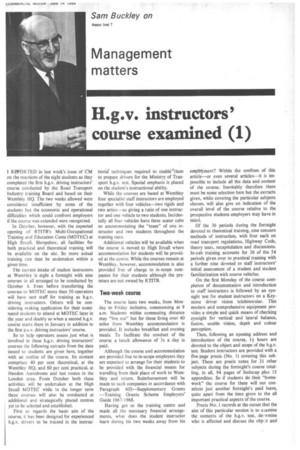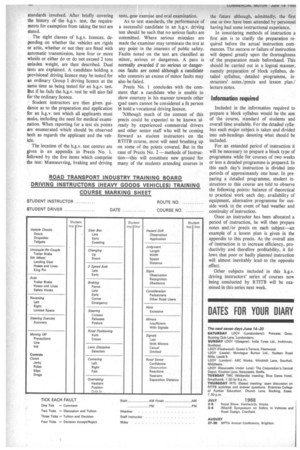H.g.v. instructors'
Page 69

Page 70

If you've noticed an error in this article please click here to report it so we can fix it.
course examined (1)
I REPORTED in last week's issue of CM on the reactions of the eight students as they completed the first h.g.v. driving instructors' course conducted by the Road Transport Industry training Board and based on their Wembley HQ. The two weeks allowed were considered insufficient by some of the students but the economic and operational difficulties which could confront employers if the course was extended were recognized.
In October, however, with the expected opening of RTITB's Multi-Occupational Training and Education Cente (MOTEC) at High Ercall, Shropshire, all facilities for both practical and theoretical training will be available on the site. So more actual training can then be undertaken within a given time.
The current intake of student instructors at Wembley is eight a fortnight with nine courses in all arranged to be conducted by October 4. Even before transferring the courses to MOTEC more than 50 operators will have sent staff for training as h.g.v. driving instructors. Others will be considering making application for their nominated students to attend at MOTEC later in the year and doubly so when a second h.g.v. course starts there in January in addition to the first p.s.v. driving instructors' course.
So to help operators assess just what is involved in these h.g.v. driving instructors' courses the following extracts from the data issued to students are given here, together with an outline of the course. Its content comprises 40 per cent theoretical, at the Wembley HQ, and 60 per cent practical, at Hendon Aerodrome and test routes in the London area. From October both these activities will be undertaken at the High Ercall MOTEC while in the longer term these courses will also be conducted at additional and strategically placed centres yet to be selected and established.
First as regards the basic aim of the course, it has been designed for experienced h.g.v. drivers to be trained in the instruc tiodaltechniques required to enablethem to prepare drivers for the Ministry of Transport h.g.v. test. Special emphasis is placed on the student's instructional ability.
While the courses are based at Wembley four specialist staff instructors are employed together with four vehicles—two rigids and two artics—so giving a ratio of one instructor and one vehicle to two students. Incidentally all four vehicles have three seater cabs so accommodating the "team" of one instructor and two students throughout the training runs.
Additional vehicles will be available when the course is moved to High Ercall where accommodation for students will be provided at the centre % While the courses remain at Wembley, however, accommodation is also provided free of charge to in-scope companies for their students although the premises are not owned by RITTB.
Two-week course
The course lasts two weeks, from Monday to Friday inclusive, commencing at 9 a.m. Students within commuting distance may "live out" but for those living over 40 miles from Wembley accommodation is provided. It includes breakfast and evening meals. To facilitate the conduct of the course a lunch allowance of 3s a day is paid.
Although the course and accommodation are provided free to in-scope employers they are expected to arrange for their students to be provided with the financial means for travelling from their place of work to Wembley and return. Reimbursement will be made to such companies in accordance with Paragraph 6(0—Supplementary Grants —Training Grants Scheme Employers' Guide 1967-1968.
Having got to the training centre and made all the necessary financial arrangements, what does the student instructor learn during his two weeks away from his
entpktyment? Within the confines of this article—or even .several articles—it is impossible to include all the data and content of the course. Inevitably therefore there must be some selection here but the extracts given, while covering the particular subjects chosen, will also give an indication of the overall level of the course relative to the prospective students employers may have in mind.
Of the 36 periods during the fortnight devoted to theoretical training, nine concern methods of instruction, with four each on road transport regulations, Highway Code, theory tests, recapitulation and discussions. In-cab training accounts for 36 of the 54 periods given over to practical training with a further nine devoted to staff instructors' initial assessment of a student and student familiarization with course vehicles.
On the first Monday of the course completion of documentation and introduction to staff instructors is followed by an eyesight test for student instructors on a Keystone driver vision telebinocular. This modern and comprehensive equipment provides a simple and quick means of checking eyesight for vertical and lateral balance, fusion, usable vision, depth and colour perception.
Then, following an opening address and introduction of the course, 14hours are devoted to the object and scope of the h.g.v. test. Student instructors are provided with a five-page precis (No. 1) covering this subject. These are precis notes for 31 other subjects during the fortnight's course totalling, in all, 94 pages of foolscap plus 15 appendides. So if students do their "homework" the course for them will not constitute just another fortnight's paid leave, quite apart from the time given to the all important practical aspects of the course.
Precis No. 1 records at the outset that the aim of this particular session is to examine the contents of the h.g.v. test, deormine who is affected and discuss the obje:t and standards involved. After briefly covering the history of the h.g.v. test, the requirements for exemption from taking the test are stated.
The eight classes of h.g.v. licences, depending on whether the vehicles are rigids or artic, whether or not they are fitted with automatic transmission, have four or more wheels or either do or do not exceed 2 tons unladen weight, are then described. Dual tests are explained. A candidate holding a provisional driving licence may be tested for an ordinary Group I driving licence at the same time as being tested for an h.g.v. test. But if he fails the h.g.v. test he will also fail for the ordinary licence.
• Student instructors are then given guidance as to the preparation and application for an h.g.v. test which all applicants must make, including the need for medical examination. When reporting for a test six points are enumerated which should be observed both as regards the applicant and the vehicle.
The location of the h.g.v. test centres are given in an appendix to Precis No. 1. followed by the five items which comprise the test: Manoeuvring, braking and driving tests, gear exercise and oral examination.
As to test standards, the performance of a successful candidate in an h.g.v. driving test should be such that no serious faults are committed. Where serious mistakes are made the examiner may terminate the test at any point in the interests of public safety. Faults noted on the test are classified as minor, serious or dangerous. A pass is normally awarded if no serious or dangerous faults are noted although a candidate who commits an excess of minor faults may also be failed.
Precis No. 1 concludes with the comment that a candidate who is unable to show courtesy in his manner towards other read users cannot be considered a fit person to hold a vocational driving licence.
'Although much of the content of this precis could be expected to be known already by experienced commercial drivers and other senior staff who will be coming forward as student instructors on the RTITB course, most will need brushing up on some of the points covered. But in the case of Precis No. 2— methods of Instruction—this will constitute new ground for many of the students attending courses in the future although, admittedly, the first one or two have been attended by personnel having had some instructional experience.
In considering methods of instruction a first aim is to clarify the preparation required before the actual instruction commences. The success or failure of instruction will depend greatly upon the thoroughness of the preparation made beforehand. This should be carried out in a logical manner, namely preparation of block syllabus, detailed syllabus, detailed programme, instructors' notes /precis and lesson plan / lecture notes.
Information required
Included in the information required to prepare a block syllabus would be the aim of the course, standard of students and overall time available. For the detailed syllabus each major subject is taken and divided into sub-headings denoting what should be included.
For an extended period of instruction it will be necessary to prepare a block type of programme while for courses of two weeks or less a detailed programme is prepared. In this each day's instruction is divided into periods of approximately one hour. In preparing a detailed programme, student instructors to this course are told to observe the following points: balance of theoretical to practical work each day, availability of equipment, alternative programme for outside work in the event of bad weather and continuity of instruction.
Once an instructor has been allocated a period of instruction, he will then prepare notes and/or precis on each subject—an example of a lesson plan is given in the appendix to this precis. As the overall aim of instruction is to increase efficiency, productivity and therefore profitability, it follows that poor or badly planned instruction will almost inevitably lead. to the opposite effect.
Other subjects included in this h.g.v. driving instructors' series of courses now being conducted by RTITB will be examined in this, series next week.




























































































































